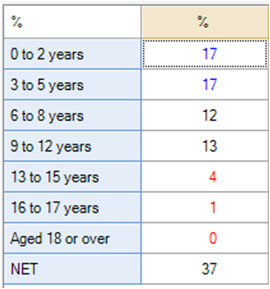NET
A NET is a combination of categories on a Categorical Question. A NET is always computed in the same way: it represents the proportion of respondents (i.e., cases) to have selected one or more of the categories and have no missing data.
NET with mutually exclusive categories
With mutually exclusive categories, such as gender, a NET is the sum of categories: 51% males + 49% females = 100% NET. Thus, with Pick One and Pick One - Multi questions, a NET is in essence a total.
NET with categories that are not mutually exclusive
The following table shows awareness data, where people were permitted to be aware of 1 or more brands (it is a Pick Any question). Note that the NET here is not a total. Where the categories overlap, the NET will always be less than or equal to the sum of the categories, except where there is missing data (this is discussed in more detail below).
NET with categories that are not exhaustive
A NET is only 100% if the categories it represents are exhaustive. The example below shows ages of children in families. The NET is not the sum of the categories above, because people can have more than one child. And, it is not 100% because people in the sample have no children.
See NET is not 100% for a discussion of options when you wish to force the NET to be 100%.
NET with missing data
Cases with any missing data are excluded from the NET. In the table on the left, all the brands have a sample size of 327 except for Pepsi Light, which has a sample size of 314 due to 13 cases with missing data (i.e., Missing n). In this example, the NET is computed using only the 314 cases that have complete data (i.e., Pepsi Light and all the other brands).
In the table to the right many of the brands have missing data, and as a total of 21 cases have some missing data, the Base n used in computation of the NET is 306.
By definition the Base n for the NET must always be less than or equal to the smallest Base n shown in a SUMMARY table. For the same reason, the Column n shown for the NET row in a crosstab and shown in Statistics - Below must always less than or equal to the smallest Column n in that column.
See Column n Is Too Small for a discussion of options when you wish to display a different sample size.
Creating a NET
NETs are automatically created when a project is setup in in Q. Further NETs can be created by selecting multiple categories, right clicking and selecting Create NET (see Manipulating Data).
The NETs that are automatically created (i.e., which, by default, are shown at the base and to the right of tables) are no different to NETs that are manually created using Create NET.


